Stage 4 Mathematics: Practical Investigation - Dice World Task
VerifiedAdded on 2022/11/07
|16
|2411
|346
Homework Assignment
AI Summary
This assignment, a practical investigation in Stage 4 Mathematics, focuses on statistics and probability using dice. Students are tasked with rolling two dice, recording results, and performing various calculations and analyses. The assignment includes constructing frequency histograms and dot plots, calculating probabilities for single and double-digit numbers, and comparing experimental results with theoretical expectations. Students are required to analyze the shape, spread, and peaks of data distributions, and to compare different data displays like frequency histograms and stem-and-leaf plots. The investigation also involves creating and comparing dot plots based on adding and multiplying the dice values, and explaining any observed similarities or differences. Finally, the assignment requires students to predict and interpret the results of further dice rolls, reinforcing their understanding of probability and statistical concepts.

Senior School Assessment Task
Notification and Information
SS Task Course:Stage 4 Mathematics-YANGAH Due Date: Monday 16th September (Week 8)
Task Title: Practical Investigation
Components
(Syllabus)
Weightings
(Percentages)
Topic Studied:
Working Mathematically 5% Statistics
Probability
Percentages/fractions
Mathematical reasoning 5%
Number and Algebra 5%
Measurement and
Geometry
5%
Statistics and Probability 5%
Total Weighting: 25%
Notification and Information
SS Task Course:Stage 4 Mathematics-YANGAH Due Date: Monday 16th September (Week 8)
Task Title: Practical Investigation
Components
(Syllabus)
Weightings
(Percentages)
Topic Studied:
Working Mathematically 5% Statistics
Probability
Percentages/fractions
Mathematical reasoning 5%
Number and Algebra 5%
Measurement and
Geometry
5%
Statistics and Probability 5%
Total Weighting: 25%
Paraphrase This Document
Need a fresh take? Get an instant paraphrase of this document with our AI Paraphraser

NESA Outcomes
MA4-19SP collects, represents and interprets single sets of data, using appropriate statistical displays
MA4-21SP represents probabilities of simple and compound events
MA4-1WM Communicates and connects mathematical ideas using appropriate terminology, diagrams and symbols
MA4-2WM Applies appropriate mathematical techniques to solve problems
MA4-3WM Recognises and explains mathematical relationships using reasoning
MA4-5NA Operates with Fractions, decimals and percentages
MA4-11NA creates and displays number patterns
Mathematics Stage 4 - Dice World
Task 1
Roll 2 dice 20 times each (or one dice 40 times) and record your results in the table below in the lines for Dice A and Dice B.
Finish the table by completing the last three rows, using the instructions embedded in the questions throughout the assignment.
Roll 1 2 3 4 5 6 7 8 9 10 11 12 13 14 15 16 17 18 19 20
Dice A 2 4 1 2 3 2 2 4 5 6 1 6 2 5 1 4 2 6 6 1
Dice B 4 2 2 3 4 1 4 5 4 4 6 3 4 6 4 2 4 3 1 2
A + B 6 6 3 5 7 3 6 9 9 10 7 9 6 11 5 6 6 9 7 3
A B 8 8 2 6 12 2 8 20 20 24 6 18 8 30 4 8 8 18 6 2
Q1
2-digit number
i.e AB
24 42 12 23 34 21 24 45 54 64 16 63 24 56 14 42 24 63 61 12
MA4-19SP collects, represents and interprets single sets of data, using appropriate statistical displays
MA4-21SP represents probabilities of simple and compound events
MA4-1WM Communicates and connects mathematical ideas using appropriate terminology, diagrams and symbols
MA4-2WM Applies appropriate mathematical techniques to solve problems
MA4-3WM Recognises and explains mathematical relationships using reasoning
MA4-5NA Operates with Fractions, decimals and percentages
MA4-11NA creates and displays number patterns
Mathematics Stage 4 - Dice World
Task 1
Roll 2 dice 20 times each (or one dice 40 times) and record your results in the table below in the lines for Dice A and Dice B.
Finish the table by completing the last three rows, using the instructions embedded in the questions throughout the assignment.
Roll 1 2 3 4 5 6 7 8 9 10 11 12 13 14 15 16 17 18 19 20
Dice A 2 4 1 2 3 2 2 4 5 6 1 6 2 5 1 4 2 6 6 1
Dice B 4 2 2 3 4 1 4 5 4 4 6 3 4 6 4 2 4 3 1 2
A + B 6 6 3 5 7 3 6 9 9 10 7 9 6 11 5 6 6 9 7 3
A B 8 8 2 6 12 2 8 20 20 24 6 18 8 30 4 8 8 18 6 2
Q1
2-digit number
i.e AB
24 42 12 23 34 21 24 45 54 64 16 63 24 56 14 42 24 63 61 12
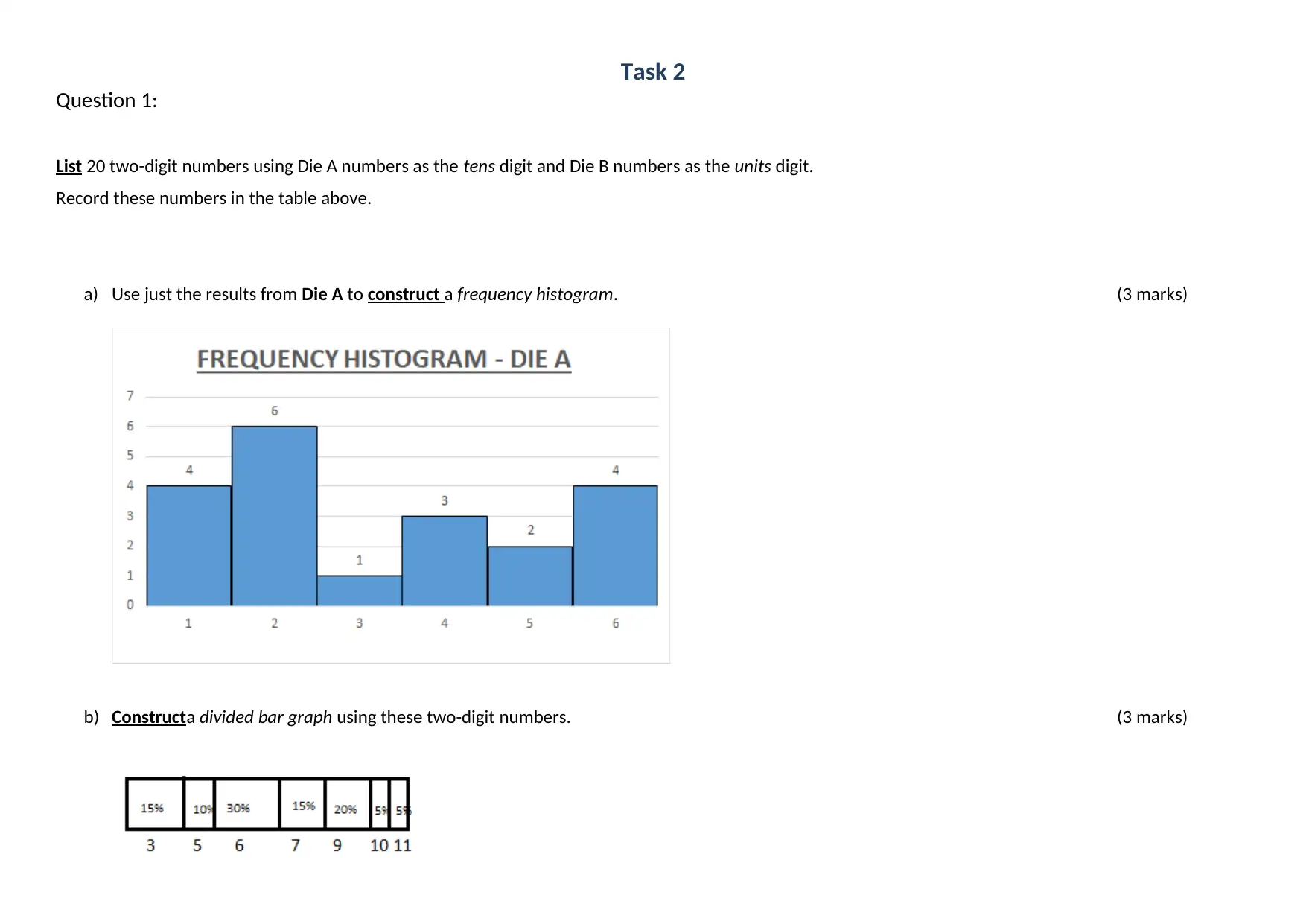
Task 2
Question 1:
List 20 two-digit numbers using Die A numbers as the tens digit and Die B numbers as the units digit.
Record these numbers in the table above.
a) Use just the results from Die A to construct a frequency histogram. (3 marks)
b) Constructa divided bar graph using these two-digit numbers. (3 marks)
Question 1:
List 20 two-digit numbers using Die A numbers as the tens digit and Die B numbers as the units digit.
Record these numbers in the table above.
a) Use just the results from Die A to construct a frequency histogram. (3 marks)
b) Constructa divided bar graph using these two-digit numbers. (3 marks)
⊘ This is a preview!⊘
Do you want full access?
Subscribe today to unlock all pages.

Trusted by 1+ million students worldwide
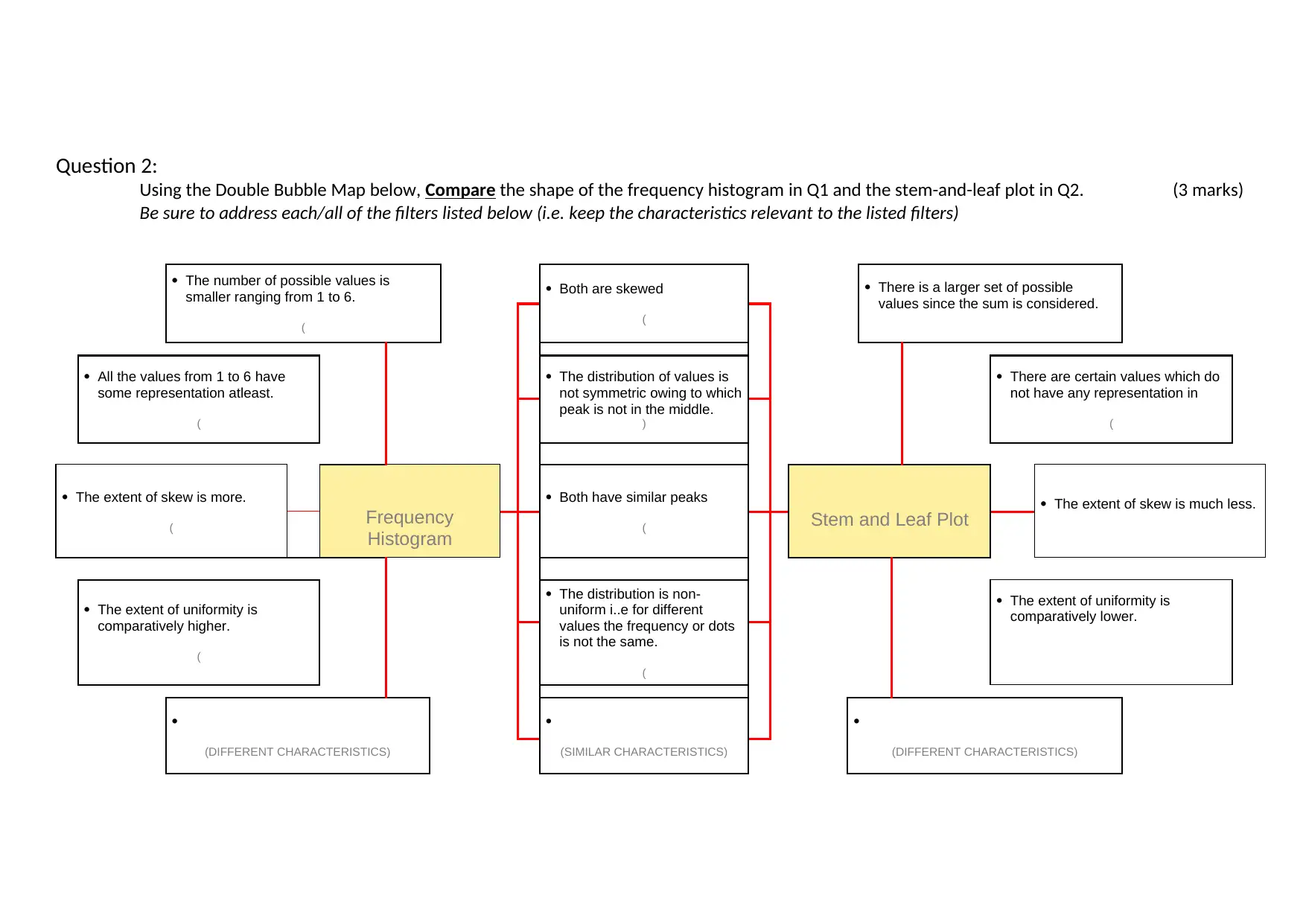
Question 2:
Using the Double Bubble Map below, Compare the shape of the frequency histogram in Q1 and the stem-and-leaf plot in Q2. (3 marks)
Be sure to address each/all of the filters listed below (i.e. keep the characteristics relevant to the listed filters)
The number of possible values is
smaller ranging from 1 to 6.
(
Both are skewed
(
There is a larger set of possible
values since the sum is considered.
All the values from 1 to 6 have
some representation atleast.
(
The distribution of values is
not symmetric owing to which
peak is not in the middle.
)
There are certain values which do
not have any representation in
(
The extent of skew is more.
( Frequency
Histogram
Both have similar peaks
( Stem and Leaf Plot The extent of skew is much less.
The extent of uniformity is
comparatively higher.
(
The distribution is non-
uniform i..e for different
values the frequency or dots
is not the same.
(
The extent of uniformity is
comparatively lower.
(DIFFERENT CHARACTERISTICS)
(SIMILAR CHARACTERISTICS)
(DIFFERENT CHARACTERISTICS)
Using the Double Bubble Map below, Compare the shape of the frequency histogram in Q1 and the stem-and-leaf plot in Q2. (3 marks)
Be sure to address each/all of the filters listed below (i.e. keep the characteristics relevant to the listed filters)
The number of possible values is
smaller ranging from 1 to 6.
(
Both are skewed
(
There is a larger set of possible
values since the sum is considered.
All the values from 1 to 6 have
some representation atleast.
(
The distribution of values is
not symmetric owing to which
peak is not in the middle.
)
There are certain values which do
not have any representation in
(
The extent of skew is more.
( Frequency
Histogram
Both have similar peaks
( Stem and Leaf Plot The extent of skew is much less.
The extent of uniformity is
comparatively higher.
(
The distribution is non-
uniform i..e for different
values the frequency or dots
is not the same.
(
The extent of uniformity is
comparatively lower.
(DIFFERENT CHARACTERISTICS)
(SIMILAR CHARACTERISTICS)
(DIFFERENT CHARACTERISTICS)
Paraphrase This Document
Need a fresh take? Get an instant paraphrase of this document with our AI Paraphraser

Question3:
a) Calculate the probabilities for the single number (Die A)with thehighest frequency and the double-digit number with the highest frequency.
Give your answer as a fraction and a percentage. (3 marks)
Single Numbers: P(2)= 6 /20 = 30 %
Double Digit Numbers: P(24) = 4/20 = 20 %
b) Calculate the probabilities for the single number (Die A)with the lowest frequency and the double-digit number with the lowest frequency.
Give your answer as a fraction and a percentage. (3 marks)
Single Numbers: P(3)=1/20 = 5 %
Double Digit Numbers: P(14) =1/20 = 5 %
c) Predict what the frequency histogram may look like if we throw the dice another twenty times and record our results.
Give your answer as a paragraph (3-5 sentences) and a sketched graph. (2 marks)
The frequency histogram would not look similar to the one which has been obtained for dice A. Also, it would not be expected to be similar to the
theoretical expectation where each outcome should have equal occurrence. The requisite graph is shown below for another 20 throws of dice and it is
evident that it does not mirror the theoretical expectation nor dice A.
Filter 1: Symmetry Filter 2: Uniform Filter 3: Skewness Filter 4: Peaks
a) Calculate the probabilities for the single number (Die A)with thehighest frequency and the double-digit number with the highest frequency.
Give your answer as a fraction and a percentage. (3 marks)
Single Numbers: P(2)= 6 /20 = 30 %
Double Digit Numbers: P(24) = 4/20 = 20 %
b) Calculate the probabilities for the single number (Die A)with the lowest frequency and the double-digit number with the lowest frequency.
Give your answer as a fraction and a percentage. (3 marks)
Single Numbers: P(3)=1/20 = 5 %
Double Digit Numbers: P(14) =1/20 = 5 %
c) Predict what the frequency histogram may look like if we throw the dice another twenty times and record our results.
Give your answer as a paragraph (3-5 sentences) and a sketched graph. (2 marks)
The frequency histogram would not look similar to the one which has been obtained for dice A. Also, it would not be expected to be similar to the
theoretical expectation where each outcome should have equal occurrence. The requisite graph is shown below for another 20 throws of dice and it is
evident that it does not mirror the theoretical expectation nor dice A.
Filter 1: Symmetry Filter 2: Uniform Filter 3: Skewness Filter 4: Peaks
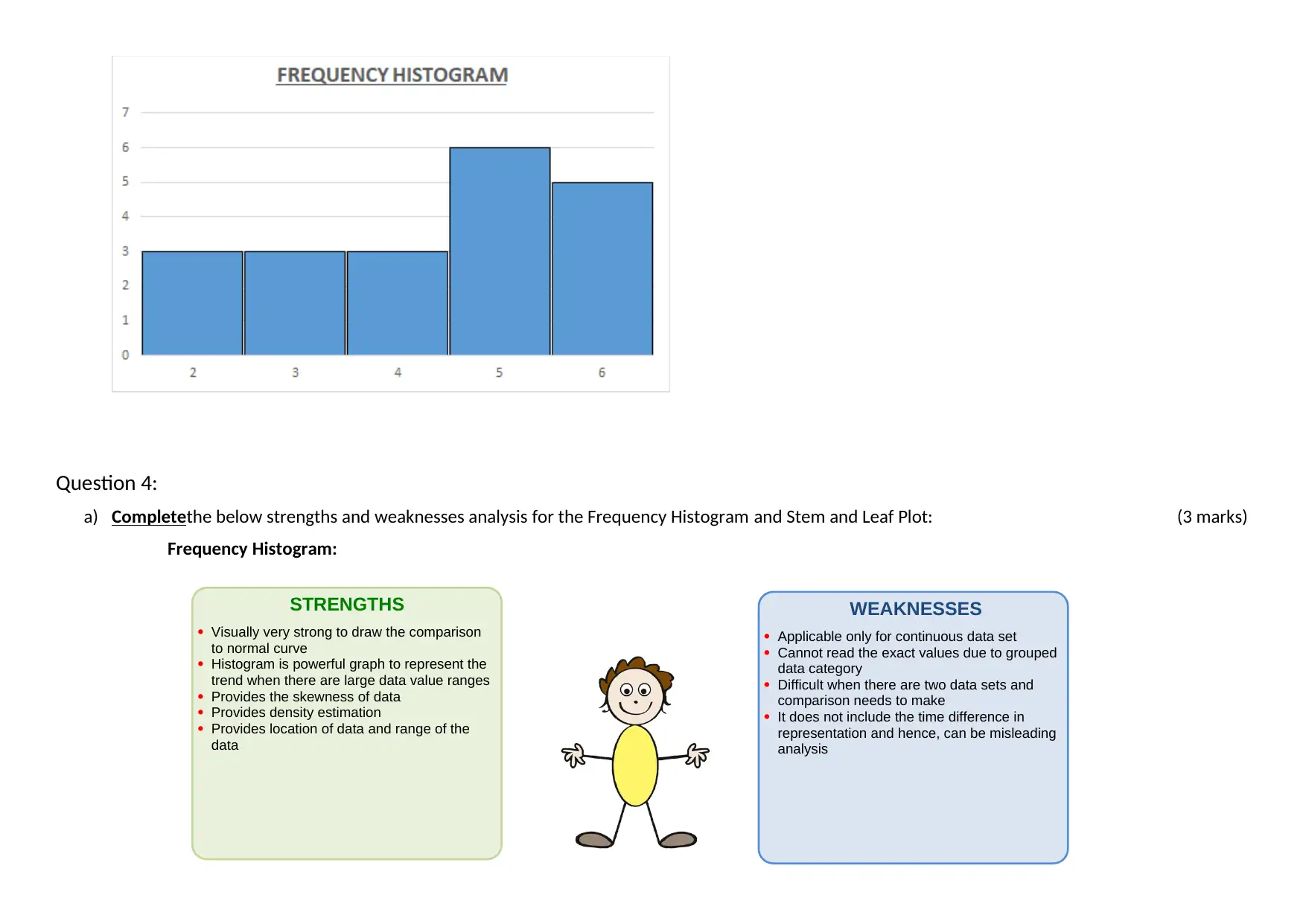
Question 4:
a) Completethe below strengths and weaknesses analysis for the Frequency Histogram and Stem and Leaf Plot: (3 marks)
Frequency Histogram:
STRENGTHS
Visually very strong to draw the comparison
to normal curve
Histogram is powerful graph to represent the
trend when there are large data value ranges
Provides the skewness of data
Provides density estimation
Provides location of data and range of the
data
WEAKNESSES
Applicable only for continuous data set
Cannot read the exact values due to grouped
data category
Difficult when there are two data sets and
comparison needs to make
It does not include the time difference in
representation and hence, can be misleading
analysis
a) Completethe below strengths and weaknesses analysis for the Frequency Histogram and Stem and Leaf Plot: (3 marks)
Frequency Histogram:
STRENGTHS
Visually very strong to draw the comparison
to normal curve
Histogram is powerful graph to represent the
trend when there are large data value ranges
Provides the skewness of data
Provides density estimation
Provides location of data and range of the
data
WEAKNESSES
Applicable only for continuous data set
Cannot read the exact values due to grouped
data category
Difficult when there are two data sets and
comparison needs to make
It does not include the time difference in
representation and hence, can be misleading
analysis
⊘ This is a preview!⊘
Do you want full access?
Subscribe today to unlock all pages.

Trusted by 1+ million students worldwide
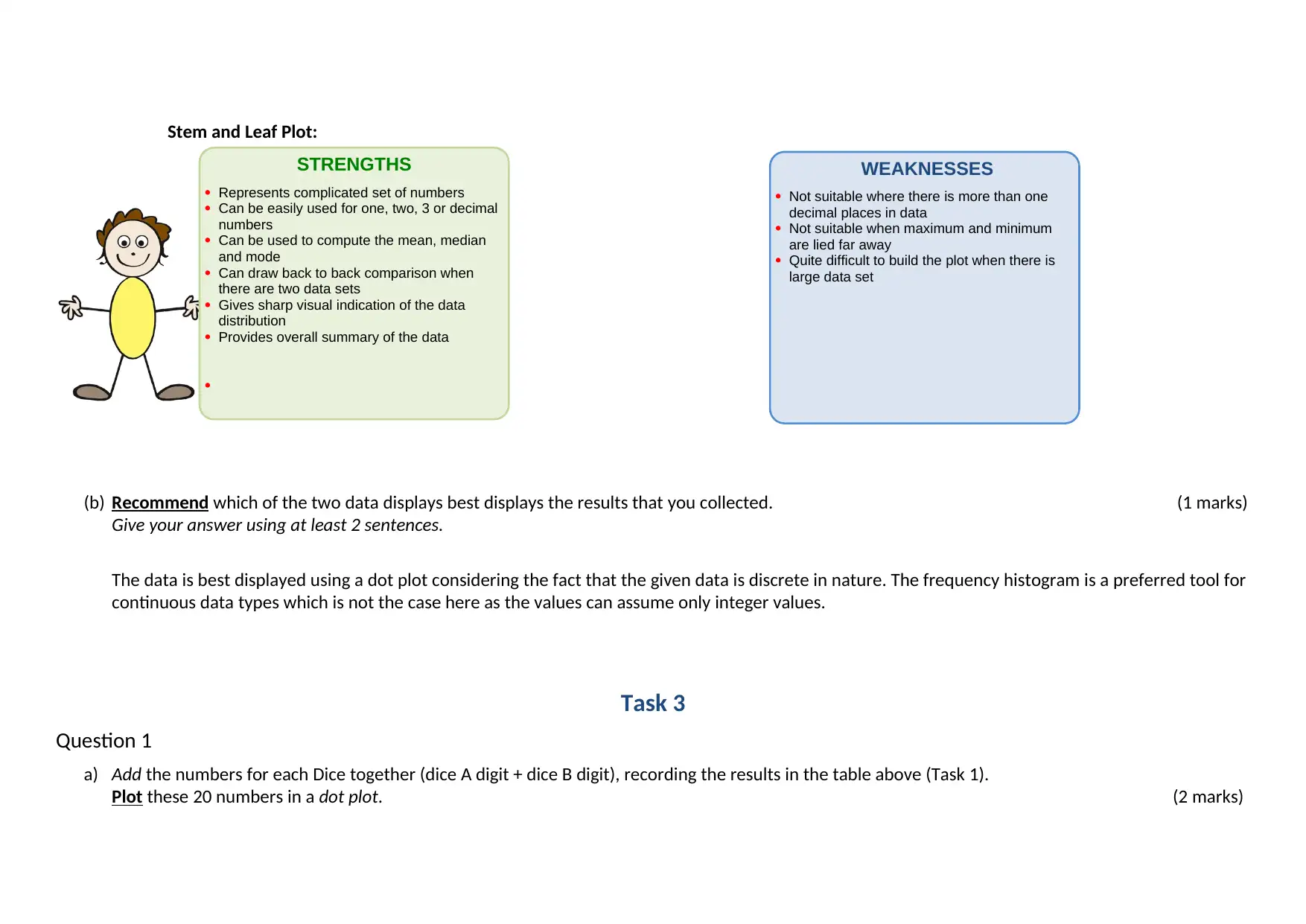
Stem and Leaf Plot:
(b) Recommend which of the two data displays best displays the results that you collected. (1 marks)
Give your answer using at least 2 sentences.
The data is best displayed using a dot plot considering the fact that the given data is discrete in nature. The frequency histogram is a preferred tool for
continuous data types which is not the case here as the values can assume only integer values.
Task 3
Question 1
a) Add the numbers for each Dice together (dice A digit + dice B digit), recording the results in the table above (Task 1).
Plot these 20 numbers in a dot plot. (2 marks)
STRENGTHS
Represents complicated set of numbers
Can be easily used for one, two, 3 or decimal
numbers
Can be used to compute the mean, median
and mode
Can draw back to back comparison when
there are two data sets
Gives sharp visual indication of the data
distribution
Provides overall summary of the data
WEAKNESSES
Not suitable where there is more than one
decimal places in data
Not suitable when maximum and minimum
are lied far away
Quite difficult to build the plot when there is
large data set
(b) Recommend which of the two data displays best displays the results that you collected. (1 marks)
Give your answer using at least 2 sentences.
The data is best displayed using a dot plot considering the fact that the given data is discrete in nature. The frequency histogram is a preferred tool for
continuous data types which is not the case here as the values can assume only integer values.
Task 3
Question 1
a) Add the numbers for each Dice together (dice A digit + dice B digit), recording the results in the table above (Task 1).
Plot these 20 numbers in a dot plot. (2 marks)
STRENGTHS
Represents complicated set of numbers
Can be easily used for one, two, 3 or decimal
numbers
Can be used to compute the mean, median
and mode
Can draw back to back comparison when
there are two data sets
Gives sharp visual indication of the data
distribution
Provides overall summary of the data
WEAKNESSES
Not suitable where there is more than one
decimal places in data
Not suitable when maximum and minimum
are lied far away
Quite difficult to build the plot when there is
large data set
Paraphrase This Document
Need a fresh take? Get an instant paraphrase of this document with our AI Paraphraser
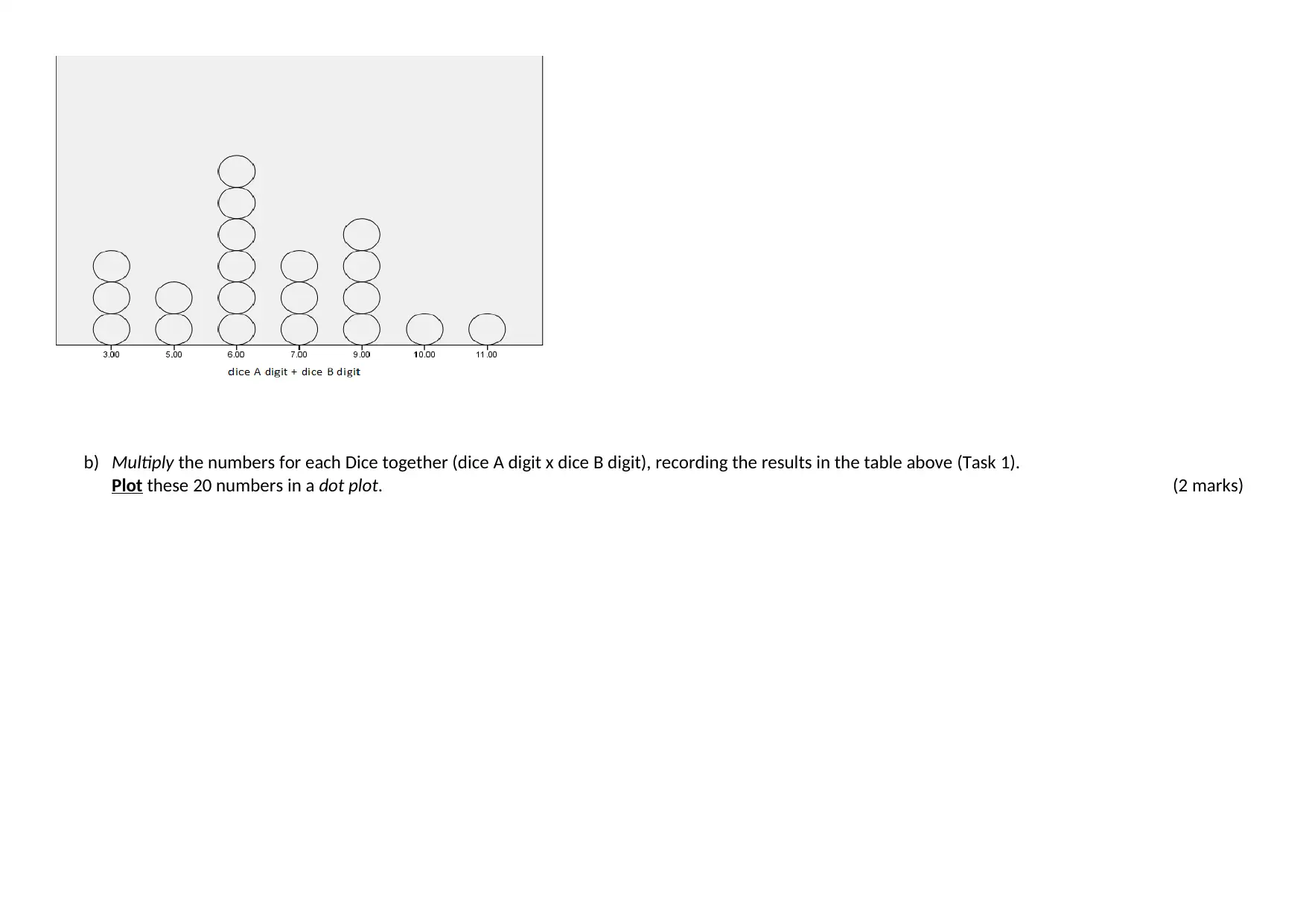
b) Multiply the numbers for each Dice together (dice A digit x dice B digit), recording the results in the table above (Task 1).
Plot these 20 numbers in a dot plot. (2 marks)
Plot these 20 numbers in a dot plot. (2 marks)

c) Compare the dot plots from Q1a) and b). (3 marks)
Be sure to address each/all of the filters listed below (i.e. keep the characteristics relevant to the listed filters)
The spread is lesser since possible
outcomes are lesser.
(
Peak is the same for both
box plots.
(
The spread is more since possible
outcomes are more
(
Extent of skew is comparatively
more.
(
Both boxplots indicate the
presence of skew.
)
Extent of skew is comparatively
lesser.
(
Be sure to address each/all of the filters listed below (i.e. keep the characteristics relevant to the listed filters)
The spread is lesser since possible
outcomes are lesser.
(
Peak is the same for both
box plots.
(
The spread is more since possible
outcomes are more
(
Extent of skew is comparatively
more.
(
Both boxplots indicate the
presence of skew.
)
Extent of skew is comparatively
lesser.
(
⊘ This is a preview!⊘
Do you want full access?
Subscribe today to unlock all pages.

Trusted by 1+ million students worldwide
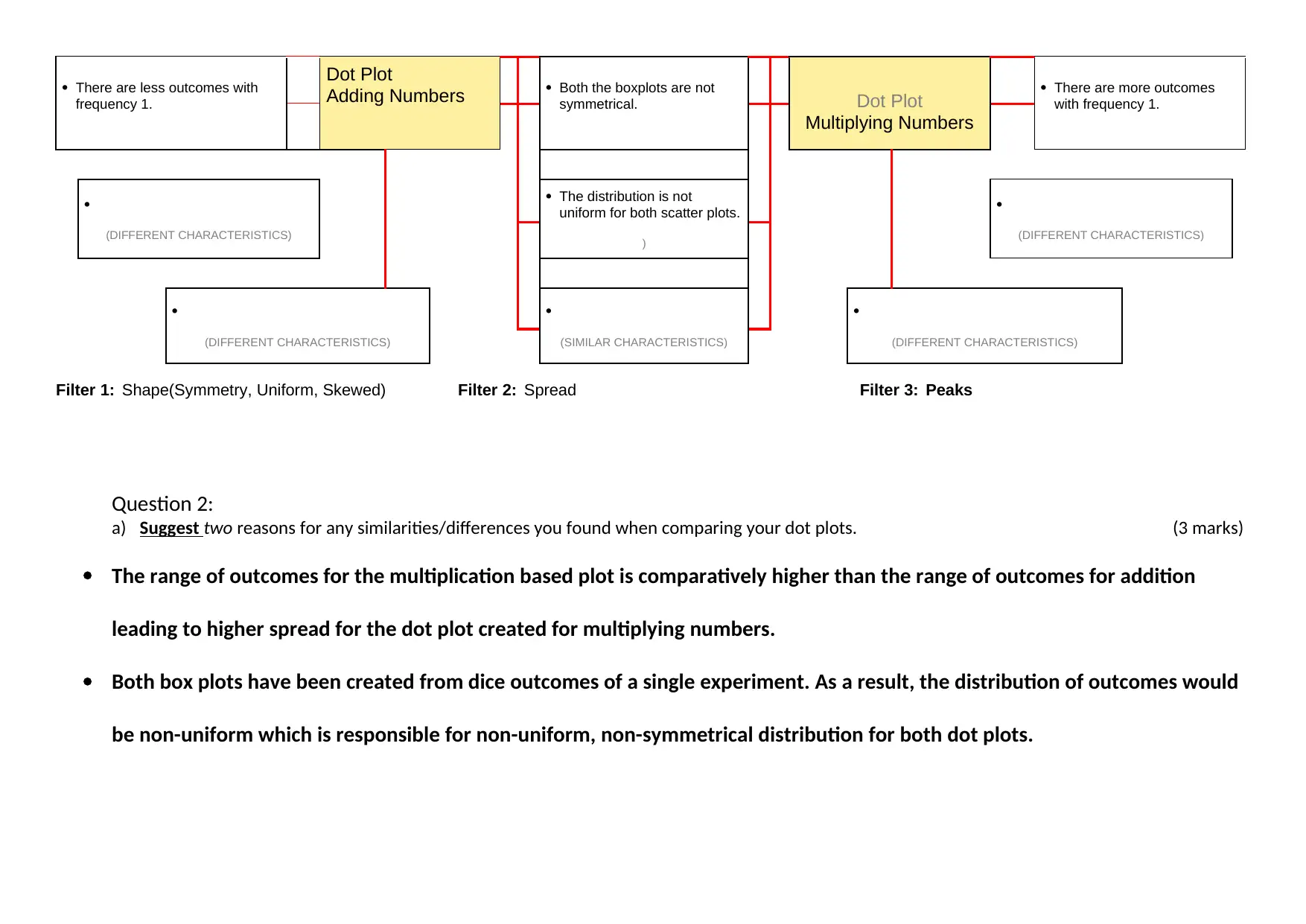
There are less outcomes with
frequency 1.
Dot Plot
Adding Numbers Both the boxplots are not
symmetrical. Dot Plot
Multiplying Numbers
There are more outcomes
with frequency 1.
(DIFFERENT CHARACTERISTICS)
The distribution is not
uniform for both scatter plots.
)
(DIFFERENT CHARACTERISTICS)
(DIFFERENT CHARACTERISTICS)
(SIMILAR CHARACTERISTICS)
(DIFFERENT CHARACTERISTICS)
Filter 1: Shape(Symmetry, Uniform, Skewed) Filter 2: Spread Filter 3: Peaks
Question 2:
a) Suggest two reasons for any similarities/differences you found when comparing your dot plots. (3 marks)
The range of outcomes for the multiplication based plot is comparatively higher than the range of outcomes for addition
leading to higher spread for the dot plot created for multiplying numbers.
Both box plots have been created from dice outcomes of a single experiment. As a result, the distribution of outcomes would
be non-uniform which is responsible for non-uniform, non-symmetrical distribution for both dot plots.
frequency 1.
Dot Plot
Adding Numbers Both the boxplots are not
symmetrical. Dot Plot
Multiplying Numbers
There are more outcomes
with frequency 1.
(DIFFERENT CHARACTERISTICS)
The distribution is not
uniform for both scatter plots.
)
(DIFFERENT CHARACTERISTICS)
(DIFFERENT CHARACTERISTICS)
(SIMILAR CHARACTERISTICS)
(DIFFERENT CHARACTERISTICS)
Filter 1: Shape(Symmetry, Uniform, Skewed) Filter 2: Spread Filter 3: Peaks
Question 2:
a) Suggest two reasons for any similarities/differences you found when comparing your dot plots. (3 marks)
The range of outcomes for the multiplication based plot is comparatively higher than the range of outcomes for addition
leading to higher spread for the dot plot created for multiplying numbers.
Both box plots have been created from dice outcomes of a single experiment. As a result, the distribution of outcomes would
be non-uniform which is responsible for non-uniform, non-symmetrical distribution for both dot plots.
Paraphrase This Document
Need a fresh take? Get an instant paraphrase of this document with our AI Paraphraser

b)
i. List the sample space for adding the numbers on our dice. Use a table to help you. (3 marks)
+ 1 2 3 4 5 6
1 2 3 4 5 6 7
2 3 4 5 6 7 8
3 4 5 6 7 8 9
4 5 6 7 8 9 10
5 6 7 8 9 10 11
6 7 8 9 10 11 12
ii. Rank the outcomes in order of frequency from Highest to lowest. State their probability as a fraction and a percentage (4 marks)
Outcome Fraction Percentage
7 6/36 = 0.167 16.67%
6 5/36 = 0.139 13.89%
8 5/36 = 0.139 13.89%
5 4/36 = 0.111 11.11%
9 4/36 = 0.111 11.11%
4 3/36 = 0.083 8.33%
10 3/36 = 0.083 8.33%
3 2/36 = 0.056 5.56%
11 2/36 = 0.056 5.56%
2 1/36 = 0.028 2.78%
12 1/36 = 0.028 2.78%
i. List the sample space for adding the numbers on our dice. Use a table to help you. (3 marks)
+ 1 2 3 4 5 6
1 2 3 4 5 6 7
2 3 4 5 6 7 8
3 4 5 6 7 8 9
4 5 6 7 8 9 10
5 6 7 8 9 10 11
6 7 8 9 10 11 12
ii. Rank the outcomes in order of frequency from Highest to lowest. State their probability as a fraction and a percentage (4 marks)
Outcome Fraction Percentage
7 6/36 = 0.167 16.67%
6 5/36 = 0.139 13.89%
8 5/36 = 0.139 13.89%
5 4/36 = 0.111 11.11%
9 4/36 = 0.111 11.11%
4 3/36 = 0.083 8.33%
10 3/36 = 0.083 8.33%
3 2/36 = 0.056 5.56%
11 2/36 = 0.056 5.56%
2 1/36 = 0.028 2.78%
12 1/36 = 0.028 2.78%
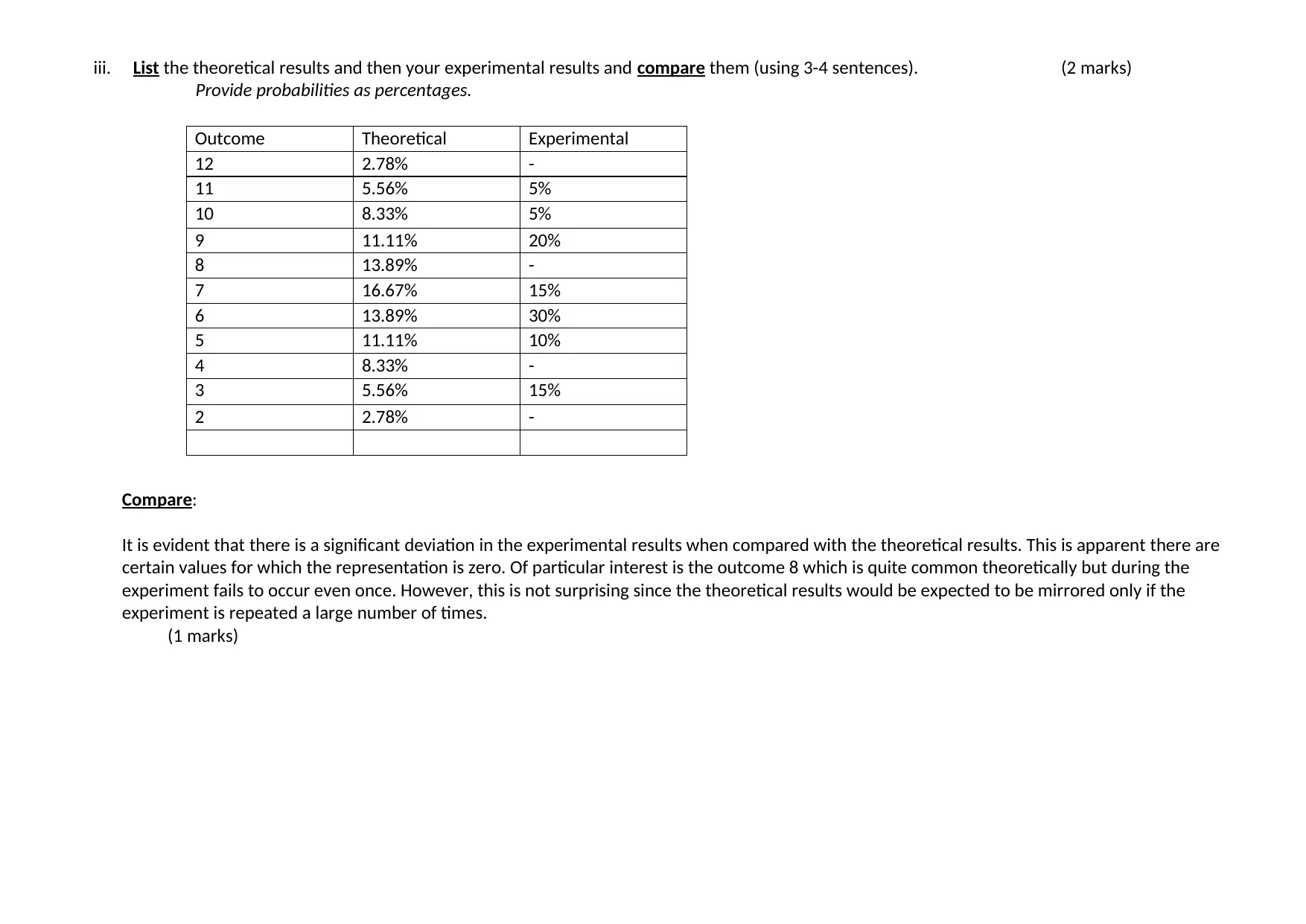
iii. List the theoretical results and then your experimental results and compare them (using 3-4 sentences). (2 marks)
Provide probabilities as percentages.
Compare:
It is evident that there is a significant deviation in the experimental results when compared with the theoretical results. This is apparent there are
certain values for which the representation is zero. Of particular interest is the outcome 8 which is quite common theoretically but during the
experiment fails to occur even once. However, this is not surprising since the theoretical results would be expected to be mirrored only if the
experiment is repeated a large number of times.
(1 marks)
Outcome Theoretical Experimental
12 2.78% -
11 5.56% 5%
10 8.33% 5%
9 11.11% 20%
8 13.89% -
7 16.67% 15%
6 13.89% 30%
5 11.11% 10%
4 8.33% -
3 5.56% 15%
2 2.78% -
Provide probabilities as percentages.
Compare:
It is evident that there is a significant deviation in the experimental results when compared with the theoretical results. This is apparent there are
certain values for which the representation is zero. Of particular interest is the outcome 8 which is quite common theoretically but during the
experiment fails to occur even once. However, this is not surprising since the theoretical results would be expected to be mirrored only if the
experiment is repeated a large number of times.
(1 marks)
Outcome Theoretical Experimental
12 2.78% -
11 5.56% 5%
10 8.33% 5%
9 11.11% 20%
8 13.89% -
7 16.67% 15%
6 13.89% 30%
5 11.11% 10%
4 8.33% -
3 5.56% 15%
2 2.78% -
⊘ This is a preview!⊘
Do you want full access?
Subscribe today to unlock all pages.

Trusted by 1+ million students worldwide
1 out of 16
Related Documents
Your All-in-One AI-Powered Toolkit for Academic Success.
+13062052269
info@desklib.com
Available 24*7 on WhatsApp / Email
![[object Object]](/_next/static/media/star-bottom.7253800d.svg)
Unlock your academic potential
Copyright © 2020–2025 A2Z Services. All Rights Reserved. Developed and managed by ZUCOL.




